 |
A is for Art Stephen T. Johnson In a sophisticated, clever exploration of visual and language arts, artist Stephen T. Johnson offers an alliterative caption explaining each alphabetically-themed illustration he created for the volume. A photograph showing a huge stack of hot-pink inflatable mattresses entitled “Meditation on the Memory of a Princess” features the caption, “Motionless, a man-made, monochromatic magenta mass mimics multiple mattresses and makes a massive mound near a mini mauve marble.” In addition to offering readers interesting interpretations of letters through collage, painting, and sculpture, Johnson incorporates playful interaction with an “I spy” alphabet hunt. Whether paged through or pensively pondered, this skillfully designed book creatively questions the idea of art for a range of readers. 2008, A Paula Wiseman Book / Simon & Schuster, Ages 7-14. $16.99. REVIEWER: CCBC (Cooperative Children’s Book Center Choices). ISBN: 9780689863011 |
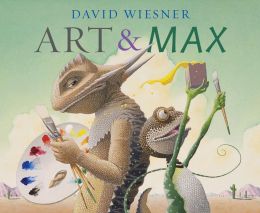 |
Art and Max David Wiesner In the desert of the American Southwest, a horned lizard named Art is just about to finish painting his masterpiece when he is interrupted by a small lizard named Max who wants to paint, too. All Max needs is a blank canvas, some paint, and an idea to get started. Art provides them all, but when he suggests to Max, “Paint me,” Max takes it literally and covers Art in colorful paint. His humorous, over-the-top attempts to get the paint off of Art playfully show different kinds of media, culminating in a simple line drawing of Art that gets deconstructed when Max begins pulling at a loose thread. As he did with his Caldecott-winning The Three Pigs (Clarion, 2001), Wiesner takes book illustration to a new intellectual plane, encouraging young readers to think about the pictures they are seeing by honing their awareness of the creative process. 2010, Clarion, Ages 5-8, $17.99. REVIEWER: CCBC (Cooperative Children’s Book Center Choices). ISBN: 9780618756636 |
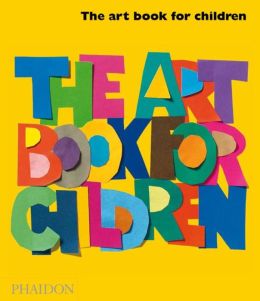 |
The Art Book for Children: Book Two Amanda Renshaw If you have ever stood in front of a work of art with a child and wished you could say something If you have ever stood in front of a work of art with a child and wished you could say something useful, this book will help. It is a second volume and consists of a series of relaxed chats about what we are looking at. In some cases’ we learn now the work came to be, in others we are taken further in and begin to notice more. Occasionally, we are let into a secret or asked to give the solution to a puzzle. Many of the examples pose questions. The scope is wide: different eras and styles, many paintings but also three dimensional works and photographs, as well as the Due de Berry’s Book of Hours. The author has an eye for the touches which will appeal, from the Duke’s dogs walking among the plates on the table to asking what we can spot in a Seurat. Great fun and useful. 2007, Phaidon Press, 12.95. REVIEWER: Pat Thomson (Carousel 38). ISBN: 9780714847054 |
 |
The Artist Who Painted a Blue Horse Eric Carle In the briefest of texts set in large type, Carle begins his tale with, ” I am an artist ” and shows us across large double pages what he paints: a blue horse, a red crocodile, a yellow cow, a pink rabbit, a green lion, an orange elephant, a purple fox, a black polar bear, and a polka-dotted donkey. He concludes, “I am a good artist.” This is followed by a reproduction of Franz Marc’s “Blue Horse 1” and a brief biography of Marc. A note on Carle offers background on his youth in Germany under the repressive Nazi regime, which declared modern art “degenerate.” But Carle found beauty in this art, and feels that his odd-colored animals were born seventy years ago in this realization. Carle’s illustrations, done in painted tissue-paper collage, are in his usual style. They capture the characteristics of each animal while eliminating all but the most basic details. The introduction of unusual colors for the animals prepares viewers for contemporary art such as Marc’s, while offering good practice in color identification. A riot of colors is splashed across the end pages. 2011, Philomel Books/Penguin Young Readers Group, Ages 3 to 6 , $17.99. REVIEWER: Ken Marantz and Sylvia Marantz (Children’s Literature). ISBN: 9780399257131 |
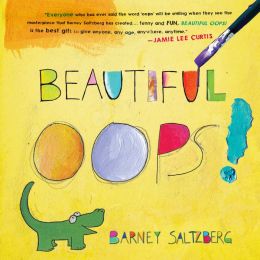 |
Beautiful Oops! Barney Saltzberg A celebration of creative thinking, Saltzberg’s small-format book encourages readers to view mistakes not as failures but opportunities. To wit, “A torn piece of paper…” (the cardboard page is actually torn) “is just the beginning”: the beginning of a smile for an alligator. Various spills and blobs are transformed into animals, a crumpled piece of paper becomes wool for a sheep, and in the book’s standout scene, a panel with a hole in the center telescopes outward, accordion-style, to reveal a tiny creature way at the bottom. Inspirational without being saccharine, this has gifty crossover potential. 2010, Workman, Ages 3 up, $11.95. REVIEWER: Publishers Weekly (Publishers Weekly). ISBN: 9780761157281 |
 |
Bridget’s Beret Tom Lichtenheld Bridget is an artist. While other kids want ice cream, Bridget is happy to sit on her picnic table and draw. But when her most prized possession a beret similar to what famous artists have worn sails away in the wind, she believes she has lost her artistic inspiration. Frantic, Bridget files a Missing Beret Report with the police, posts “Missing Beret” signs around the neighborhood, and even tries on a handful of other types of hats with the hope that they will cure her artist’s block . . . with no luck. Dismayed but persistent, Bridget’s fortune changes when her little sister Jessie asks her to make a sign for a lemonade stand, and Bridget realizes she can draw with or without her beret. Tom Lichtenheld’s humorous language, coupled with bold, colorful illustrations and clever asides, make this a hilarious book about following a passion. An author’s note on “How to Start Your Art” looks at various art styles by famous “beret-wearing” artists. 2010, Henry Holt, Ages 4-8, $16.99. REVIEWER: CCBC (Cooperative Children’s Book Center Choices). ISBN: 9780805087758 |
 |
The Dust Bowl Through the Lens: How Photography Revealed and Helped Remedy a National Disaster Martin Sandler A highly visual and accessible look at the Dust Bowl recounts the way the drought and dust storms in the southern Great Plains during the Depression profoundly affected lives and, eventually, national policy. Martin Sandler looks at this time and place in U.S. history through photographs organized around specific events or aspects of the Dust Bowl tragedy and its aftermath. Each two-page spread features a dramatic full-page photo and one or more smaller pictures accompanied by Sandler’s narrative examining various aspects of the crisis. While some of the photographic captions could have been better, the pictures are effective with or without words. Indeed, Sandler explains, the pictures played a critical role in drawing attention to the Dust Bowl across the country and confirmed the power of photography as a “universal language.” 2009, Walker, Age 11 and older, $19.99. REVIEWERS: CCBC (Cooperative Children’s Book Center Choices). ISBN: 9780802795472 |
 |
Dying to Know You Aidan Chambers Although this story is told from the point of view of a seventy-five-year-old writer, it’s all about seventeen-year old Karl, who is in love with Fiorella. Karl has sought out the assistance of a local writer of young adult novels because he needs help: Fiorella has asked him to give her written responses to several questions so she can determine whether he is worthy of her love. Karl, a dyslexic, feels incapable, and the writer is willing to help him but he has to get to know him first something that’s hard to do because Karl is inarticulate and not exactly forthcoming. Gradually, through their growing friendship, and frequent fishing trips, he learns that Karl is still grieving the death of his father years earlier and that he’s uncertain about his future. He’s happily working as a plumber’s assistant, but he has a secret urge to create sculptures. Karl’s character is revealed slowly and mostly through dialogue, through the probing, often amusing, philosophical exchanges between him and the writer. Ultimately, the story explores the role of art in a world that doesn’t understand it or care about it, and both Karl and the author grow as a result of their friendship. . 2012, Amulet, Age 14 and older, $16.95. REVIEWER: CCBC (Cooperative Children’s Book Center Choices). ISBN: 9781419701658 |
 |
Flash Burnout: A Novel L. K. Madigan High school sophomore Blake likes to give himself points whenever he delivers a funny quip, and most days Blake’s mental point tally is pretty high; he’s especially good at amusing his beautiful and caring girlfriend, Shannon. He has nothing funny to say to his friend and photography classmate Marissa, though, when it turns out that the homeless woman Blake photographed is Marissa’s estranged, meth-addicted mother. Blake decides to try and help his friend repair her broken home life, searching for Marissa’s mother and then supporting Marissa once the two are reunited. It’s clear that Blake genuinely feels for Marissa and that he’s becoming increasingly attached to her, and that results in realistically tangled implications for his feelings about and his relationship with Shannon. In Blake, Madigan presents a convincing, caring high-school boy with a tricky adult dilemma, and readers will find it easy to sympathize with the protagonist when he stumbles; in fact, all of the principal characters are treated as real people with understandable viewpoints. The book is especially good at building the relationships slowly and showing the nuances and confusion inherent in various kinds of intimacy, including the familial intimacy depicted in Blake’s relationship with older brother Garrett. The reader is never promised a happy ending, and thankfully one isn’t offered; instead, the book offers a more complex parting shot: a little hurtful, a little hopeful, much like life Review Code: R 2009, Houghton, Grades 8-10, $16.00. REVIEWER: Jeff Chang (The Bulletin of the Center for Children’s Books). ISBN: 9780547194899 |
 |
Gadget Girl: The Art of Being Invisible Suzanne Kamata Fifteen-year-old manga artist Aiko Cassidy begins a life of her own when her mother, famous for her sculptures of Aiko, wins a major award, and they move from Michigan to the City of Lights for the summer. Aiko is obsessed with meeting her estranged father, an indigo farmer in Japan, but Paris’s diversity and creative atmosphere prove to be a welcome and even inspirational substitute. There, she teams up with Hervé, a dashing 16-year-old waiter with similarly big dreams, who admires Aiko and her art and helps her negative self-image (as a klutzy, biracial girl with cerebral palsy) to fade away. In addition, Aiko improves her relationship with her mother, discovers family secrets, and gains the freedom to be herself. Kamata’s love and intimate knowledge of Paris streets add atmosphere to this smart and surprising coming-of-age story, the author’s first book for teens (it was developed from a novella previously published in Cicada magazine). Readers will feel whisked away by the romance of an artistic life and appreciate the sensitivity and honesty with which Kamata writes about Aiko’s physical and emotional journeys. 2013, Gemma, Ages 12-up, $14.95. REVIEWER: Publishers Weekly (Publishers Weekly). ISBN: 9781936846382 |
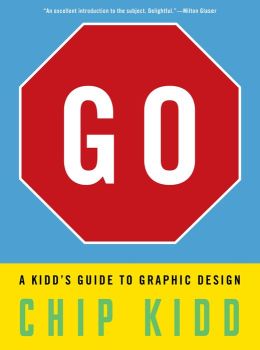 |
GO: A Kidd’s Guide to Graphic Design Chip Kidd Celebrated designer Kidd’s first lesson is on the front cover: the eight-sided red sign on it doesn’t say STOP, but GO. “The cover is weird,” Kidd writes. “But you opened it anyway. And you know what? That was a design decision.” Crammed with images and type, the book is as riotous as a walk through Times Square. A brief introduction to copyright, thoughts on the place of graphic design in the broader world of design, and a short history of graphic design lead to the heart of the book: a series of lucid, witty, and absorbing analyses of graphic design techniques, illustrated largely with book covers created by Kidd and his colleagues. They sometimes sound like descriptions of magic tricks-not a coincidence, since graphic design, like magic, is concerned with manipulating viewers’ attention. “If you simply turn an image upside down, it automatically makes the viewer not only look at it differently, but pay more attention to it.” There’s a section on typography, and an inspiring series of exercises-tomorrow’s designers will want to grab a pencil and get going. 2013, Workman, Ages 10-up., $17.95. REVIEWER: Publishers Weekly (Publishers Weekly). ISBN: 9780761172192 |
 |
I Gotta Draw Bruce Degen Charlie Muttnik is known in his Brooklyn neighborhood as “the pup with the pencil.” He’s always drawing pictures in his chaotic household, where he lives with his mother, father, and older sister. But when Charlie goes back to school, his strict new teacher, Miss Rich (a smartly dressed cat), doesn’t approve of Charlie’s doodling in class. Miss Rich has a change of attitude, however, when she realizes that Charlie learns best through his pictures. So during a spelling lesson, Charlie is allowed to draw in the back of the classroom, as long as he spells the words out loud, and for a lesson on the solar system, Charlie draws and labels the planets. Degen, illustrator of the Magic School Bus series, conveys Charlie’s spirited nature through his floppy ears, tennis shoes, striped T-shirt, and exuberant concentration as he draws. Comics-style panels mimic Charlie’s visual interpretation of the world around him, with his own art integrated into the scenes. Readers who don’t conform to a one-size-fits-all style of learning should welcome the message about creativity, classroom flexibility, and breaking the mold. 2012, Harper/HarperCollins, Ages 5-9, $16.99. REVIEWER: Publishers Weekly (Publishers Weekly). ISBN: 9780060284176 |
 |
In Her Hands: The Story of Sculptor Augusta Savage Alan Schroeder ; illustrated by JaeMe Bereal In Her Hands: The Story of Sculptor Augusta Savage is a compelling children’s biography of Harlem Renaissance sculptor Augusta Savage (1892-1962), gracefully unfolded by Alan Schroder and richly imaged in realistic paintings by JaeMe Bereal. Described as an enigmatic figure in American art, Augusta began her career as a young girl creating clay animals in Florida, despite her preacher father’s stern disapproval. Augusta faced and persevered through many difficult obstacles but she became proficient at her chosen field of art through continued scholarship-sponsored education in New York City. Suffering from illness and depression in her later life, Augusta’s reputation flagged, after some very famous works were achieved, including “The Harp” and “Gamin,” a bronze bust of a jaunty boy made in 1929. Because some of her work has been lost or destroyed, Augusta Savage is not as well remembered today as she deserves to be. In the 1930’s, however, “she was a guiding light of the Harlem Renaissance.” “In Her Hands” will appeal to an audience ages 7-13 and should be an inspiration to young artists today. Lee & Low Books, Ages 7-13, $19.95. REVIEWER: Midwest Book Review (Children’s Bookwatch). ISBN: 9781600603327 |
 |
Masterpiece Elise Broach On James Pompaday’s eleventh birthday, he receives two gifts that will forever change his life. The first is a pen-and-ink set from his artist father and the second is the start of an unexpected friendship. James has never been very artistic and he’s never had many friends, let alone one who is a common house beetle. Marvin lives with his entire beetle family inside the Pompaday’s kitchen cabinet. Unlike James, Marvin fancies himself an artist, and while James is asleep, Marvin can’t resist trying out James’s pen-and-ink set. The work he creates is a miniature masterpiece, which he leaves as a gift for James. Complications quickly develop as James is credited with creating the amazing work. The tiny landscape captures the attention of two curators at the Metropolitan Museum of Art, who marvel at its resemblance to the great works of Albrecht Durer. A fast-paced art-history mystery unfolds and James and Marvin become calamitously caught up in an art-heist as intricate as Durer’s (and Marvin’s) miniature prints. While Masterpiece is showcased as a caper its true colors shine as a story about the friendship between boy and beetle. 2008, Christy Ottaviano Books / Henry Holt, Ages 8-11, $16.95. REVIEWER: CCBC (Cooperative Children’s Book Center Choices). ISBN: 9780805082708 |
 |
Museum Trip Barbara Lehman As she so ably demonstrated in The Red Book (Houghton, 2004), Lehman is a master of wordless storytelling. Here, our hero is introduced on the jacket, pulling aside a sheet of white paper or curtain to reveal the title, with a hint of the mazes to be found inside. On the cover he is seen in the maze almost reaching the center. On the title page he is in line to board the school bus, then, on the next double-page spread, he is looking out the window as the bus drives through town. He starts the museum tour with his class, but after stopping to tie his shoe, he finds himself alone and lost. His adventures while seeking his class take him into a room with many pictures of mazes. They become large enough for him to enter. He finally reaches the center of one, which ends his tour. He leaves the museum with a smile and a medal; so was it only his imagination? Lehman uses very simple line drawings colored with watercolor and gouache paints. They create an ordinary, if curious, youngster and an art museum filled with familiar-looking sculptures and paintings that offer a challenge for readers to identify. Another challenge is the solving of the mazes. Lots to both enjoy and ponder. 2006, Houghton Mifflin Company, Ages 4 to 9, $15.00. REVIEWER: Ken Marantz and Sylvia Marantz (Children’s Literature). ISBN: 9780618581252 |
 |
My Heart is Like a Zoo Michael Hall Hall begins with animals peering through the outline of a heart on one side of a red double page. He then shows us zoo animals that include his heart shapes, one per single or double solid color page, as playful rhymed couplets describe their emotions relating to the feelings in his heart. They range from “eager as a beaver” and ” hopeful as a hungry heron fishing for a snake ” to “Brave as a lion, thoughtful as an owl, peaceful as a portly walrus lounging on a towel.” The final spread shows all the tired animals at the end of a busy day settled on the shelves above a smiling sleeping youngster. Hall’s talents as a graphic designer take on the challenge of basing the representations of twenty animals on heart shapes plus a few geometric shapes: black dots for eyes, triangles for beaks and tusks, etc. The delightfully imaginative creatures illuminate the terse text. The stencil-like animal parts are digitally created using aggressive combinations of non-textured colored shapes. For those readers tempted to try to produce similar creations, Hall demonstrates the birth of his lion on the back of the jacket, along with a challenge to count the more than 300 hearts. Do not miss the contrast of jacket and cover. 2010, Greenwillow Books/HarperCollins Children’s Books, Ages 3 to 7, $16.99. Ken Marantz and Sylvia Marantz (Children’s Literature). ISBN: 9780061915109 |
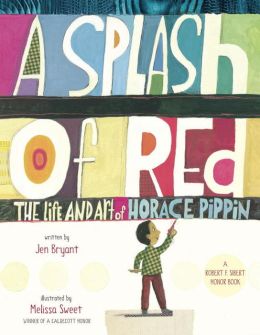 |
A Splash of Red: The Story of Horace Pippin Jen Bryant Illustrated by Melissa Sweet The team behind the Caldecott Honor book A River of Words: The Story of William Carlos Williams returns with a rewarding picture-book biography of self-taught African-American artist Horace Pippin. As a child, Pippin drew pictures at every opportunity, but his family’s economic struggles eventually necessitated that he use his “big hands” in many other roles, including “stacking grain sacks at a feed store, shoveling coal at a rail yard,” and later serving in WWI. Despite a war injury to his right arm, Pippin adapted in order to continue drawing and painting, eventually leading to recognition and fame in the art world. Sweet’s naïf mixed-media collages blend thick, solid color blocks with motifs mined from Pippin’s vibrant compositions, which range from war scenes to that of children at play. Quotations from Pippin about the psychological scars of war and his artistic process are hand-drawn into Sweet’s images, underscoring how art was not only a joyful outlet for Pippin, but also a vital means of interpreting the world. 2013, Knopf, Ages 5-8, $17.99 REVIEWER: Publishers Weekly (Publishers Weekly). ISBN: 9780375867125 |
 |
Storybook Art: Hands-on Art for Children in the Styles of 100 Great Picture Book Illustrators MaryAnn F. Kohl and Jean Potter Illustrations by Rebecca Van Slyke What a beautiful way for children to connect with their favorite storybooks! MaryAnn Kohl and Jean Potter have created an amazing resource for families; part art project book, part mini book review and part author biography. The premise is this; that by taking part in simple art projects related to familiar book illustrations, kids are encouraged to read these special books with a new enjoyment and awareness. Each of the 100 projects lists an author, a brief description of his or her book, an illustration of the project and/or materials, a small portrait of the author made by a child, a brief paragraph about their artwork (in their words or from a reliable source) and clear descriptions of the materials needed and instructions to complete the project. Some of the books included are Good Night, Moon illustrated by Clement Hurd, The Rainbow Fish by Marcus Pfister and Snow on Snow on Snow by Synthia Saint James. Many items can be easily found in any household. Icons at the top of each project page identifies the level of child experience estimated to be required for the project, the amount of adult preparation and planning involved, techniques, indoor/outdoor activities and more. Numerous indexes at the end provide even more information. Few people will know all of the stories in the book, but they will become curious about the unfamiliar ones. Highly recommended. 2003, Bright Ring Publishing, Ages: 4 to 12, $14.95. Cindy L. Carolan (Children’s Literature). ISBN: 9780935607031 |
 |
Tokyo Heist Diana Renn Sixteen-year-old Violet wishes she could magically slip into paintings, solve international mysteries, and escape the disappointments of reality like Kimono Girl, the protagonist in her own manga creation. So when she gets a chance to tag along with her artist father to Japan in the midst of a suspicious Van Gogh art robbery, it is the opportunity for which she has been waiting. Along with her best friend, Reika, the girls set out to uncover the truth of the missing sketches and the history behind a decade-old art feud. From the Seattle Art Museum to Kyoto art conservation, their inquiries drive them into close corners with the Yakuza, Japan’s most notorious gang. The mystery becomes even more dangerous when the Yakuza issues an ultimatum: deliver the missing Van Gogh sketches or they will go after Violet’s father. Tokyo Heist is a fast-paced and engaging mystery with a spunky protagonist. Since Violet is manga-obsessed, she views the world as scenes from various popular mangas and revisits suspicious events by drawing them into frames for Kimono Girl. Not only do these Kimono Girl interjections clarify the clues for Violet, but for readers as well. Although there are no actual drawings in the book, Diana Renn’s writing mirrors a manga in text form. Readers will imagine the story frame-by-frame, complete with thought bubbles and abrupt emotions. Recommend this to teens who are somewhat familiar with manga or anime jargon. 2012, Viking/Penguin, Ages 12 to 18, $17.99. REVIEWER: Jane Gov (VOYA). ISBN: 9780670013326 |
Visual Arts
 |
“This world is but a canvas to our imagination.” (H. D. Thoreau) Drawing, painting, sculpture, photography allow that imagination to soar, for the artist and the observer. Let your imagination soar with these books on various visual arts! Web links to additional information and activities about the Visual Arts follow these reviews. Contributor: Peg Glisson |
Reviews
|



